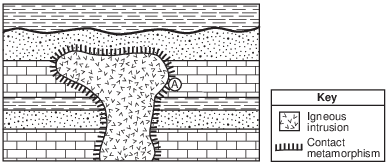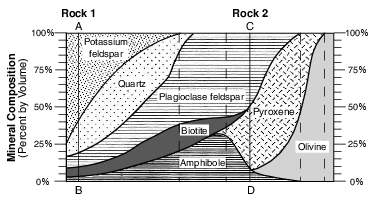Topic: Scheme For Igneous Rock Identification
Scheme For Igneous Rock Identification
Hot Spots and Mantle Plumes Research of mantle hot spots indicates that mantle plumes form in a variety of sizes and shapes. These mantle plumes range in diameter from several hundred kilometers to 1000 kilometers. Some plumes rise as blobs rather than in a continuous streak; however, most plumes are long, slender columns of hot rock slowly rising in Earth’s stiffer mantle. One theory is that most plumes form at the boundary between the outer core and the stiffer mantle. They may reach Earth’s surface in the center of plates or at plate boundaries, producing volcanoes or large domes.

The basaltic rock that forms volcanic mountains where mantle plumes reach Earth’s surface is usually composed of
(1) fine-grained, dark-colored felsic minerals
(2) fine-grained, dark-colored mafic minerals
(3) coarse-grained, light-colored felsic minerals
(4) coarse-grained, light-colored mafic minerals
The photograph below shows a magnified view of a portion of a rock that can float if placed in water.

Which terms best describe this rock?
(1) non-crystalline and vesicular
(2) coarse and non-vesicular
(3) clastic and fragmental
(4) foliated and banded
The photograph below shows an igneous rock with mineral crystals ranging in size from 2 to6 millimeters. The rock is composed of 58%
plagioclase feldspar, 26% amphibole, and 16% biotite.

What is the name of this rock?
(1) diorite
(2) gabbro
(3) andesite
(4) pumice
The igneous rock gabbro most likely formed from molten material that cooled
(1) rapidly at Earth’s surface
(2) slowly at Earth’s surface
(3) rapidly, deep underground
(4) slowly, deep underground
Which igneous rock could physically weather to beach sand that contains the minerals pyroxene, plagioclase feldspar, and olivine?
(1) dunite
(2) granite
(3) peridotite
(4) gabbro
Which igneous rock formed from magma that cooled slowly and is composed of 5% amphibole, 8% biotite, 15% plagioclase feldspar, 37% quartz, and 35% potassium feldspar?
(1) rhyolite
(2) granite
(3) diorite
(4) scoria
Which texture best describes an igneous rock that formed deep underground?
(1) glassy
(2) vesicular
(3) fine grained
(4) coarse grained
Plagioclase Feldspars
The plagioclase feldspars are a family of six silicate minerals that are difficult to tell apart. They have the same crystal structure, cleavage, and hardness, and can be similar in color; however, they do differ slightly in chemical composition and density. The general chemical composition for plagioclase is (Na,Ca)AlSi3O8. The percentages of sodium (Na) and calcium (Ca) vary relative to each other, causing the differences in density. The mineral albite is sodium-rich, with little or no calcium, while anorthite is calcium-rich, with little or no sodium. The plagioclase feldspars with higher sodium content are more likely to be found in felsic igneous rocks, while the plagioclase feldspars with higher calcium content are more likely to be found in mafic igneous rocks.

State the name of one variety of plagioclase feldspar that is more likely to be found in the igneous rock pegmatite. [1]
Allow 1 credit for albite, or oligoclase, or andesine.
• Note: Do not allow credit for “andesite” because this is an igneous rock, not a variety of feldspar.
Dimension Stone: Granite
Dimension stone is any rock mined and cut for specific purposes, such as kitchen countertops, monuments, and the curbing along city streets. Examples of rock mined for use as dimension stone include limestone, marble, sandstone, and slate. The most important dimension stone is granite; however, not all dimension stone sold as granite is actually granite. Two examples of such rock sold as “granite” are syenite and anorthosite. Syenite is a crystalline, light-colored rock composed primarily of potassium feldspar, plagioclase feldspar, biotite, and amphibole, while anorthosite is composed almost entirely of plagioclase feldspar. Like actual granite, both syenite and anorthosite have large, interlocking crystals.
State one reason why anorthosite is likely to be white to gray in color. [1]
Allow 1 credit. Acceptable responses include, but are not limited to:
• — Anorthosite is made of plagioclase feldspar, which is white to gray in color.
• — Anorthosite is made of light-colored minerals.
• — Plagioclase feldspar is white to gray.
• — because of anorthosite’s mineral composition
• Note: Do not allow credit for “anorthosite is felsic rich” because plagioclase feldspar is contained
• in both felsic-rich and mafic-rich igneous rocks.

Identify one characteristic that could be used to determine if the intrusive igneous rock has a mafic composition or a felsic composition. [1]
Allow 1 credit. Acceptable responses include, but are not limited to:
• — color/light color/dark color
• — density/low density/high density
• — mineral composition
• — rich in Al, Si, or rich in Fe, Mg
• — presence/absence of quartz/potassium feldspar/pyroxene/olivine
• Note: Do not allow credit for “composition” alone because it is stated in the question.
Based on the Earth Science Reference Tables, identify one other mineral found in some samples of diorite that is not shown in the diorite sample in the diagram. [1]
Allow 1 credit for quartz or pyroxene.
Ophiolites
In some places, segments of oceanic crust, sediment, upper mantle, and rock have been heaved up by tectonic movements onto the edges of continents, where they often become part of mountains. These displaced oceanic lithosphere segments are called ophiolites. They provide an opportunity to study the composition of oceanic lithosphere and are a key feature in recognizing past tectonic plate convergence along subduction zones. Drill-core samples of ophiolites typically have the layering pattern shown in the drill-core sample below.

What are the approximate crystal sizes in basalt and gabbro found in the Oregon drill-core sample? [1]
Basalt: ________________________________ mm
Gabbro: _______________________________ mm
Allow 1 credit if both responses are correct. Acceptable responses include, but are not limited to:
• Basalt: less than 1 mm or any value less than 1 mm. Gabbro: 1 mm to 10 mm or any value from 1 mm to 10 mm
The Mica Family
The familiar term “mica” is not the name of a specific mineral, but rather the name for a family of more than 30 minerals that share the same properties. All members of the mica family have high melting points and are similar in density, luster, hardness, streak, type of breakage, and crystal shape. As a result, telling the micas apart can be difficult. However, some common members of the family can be identified by color. For example, biotite is black to dark brown while muscovite can be light shades of several colors, or even colorless. When less common members of the mica family have any of these colors, or have similar colors, chemical tests are needed to tell them apart.
State the name of the igneous rock in which crystals of biotite mica are larger than 10 millimeters in diameter. [1]
Allow 1 credit for pegmatite.

The table in the image below shows the composition of three minerals commonly found in igneous rocks. Complete the table by placing one X in each row to indicate if that mineral is found in both rock 1 and rock 2, neither rock 1 nor rock 2, rock 1 only, or rock 2 only. [1]

Allow 1 credit if all three Xs are only placed in the correct boxes as shown below.
• Note: Allow credit if a symbol other than an X is used.
• 

Identify the general characteristics of color and density of an igneous rock composed of only the minerals olivine and pyroxene. [1]
Color: Density:
Allow 1 credit if both responses are correct. Acceptable responses include, but are not limited to:
• Color:
• — green
• — dark/darker
• — black
• — brown
• — gray
• Density:
• — high/higher
• — very dense
• — greater
• Note: Do not allow credit for any numbers for density.
